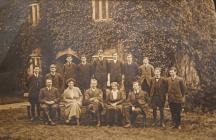Content can be downloaded for non-commercial purposes, such as for personal use or in educational resources.
For commercial purposes please contact the copyright holder directly.
Read more about the The Creative Archive Licence.
Description
Once the gravel paths in the centre and northern extent of the trench had been excavated as well as the stake holes located in the centre of the trench the decision was made to investigate the relationship of the archaeology between the gravel paths, the orangey brown soil located to the east and the pinkish brown clayey soil to the west. To achieve this, a sondage (or small trench) was excavated along the north facing trench edge (Austin & Dollery 2011). By excavating this sondage the stratigraphic relationships of these contexts, as well as any underlying features would be visible within this section of the trench. This is also particularly useful tool both for exploring archaeology as well as recording the archaeology. Recording the archaeology ‘in section’ means to both photograph and draw to an accurate scale (Usually 1:10) the trench edge, this also provides further information such as the depth of deposits as well as providing a section view rather than a bird’s eye view (Barker 1977). The sondage itself measured 6m in length (the length of the trench) and 0.5m in width.
During the excavation of the sondage further deposits were discovered as well as providing a solid context for understanding the stratigraphic relationships between these features. Directly below the gravel path a brown silty clay was discovered, within which were large compacted stones which to date has been interpreted as the foundation, or base upon which the gravel path would have been laid to provide a firm consolidated footing (Austin & Dollery 2011). Beneath this feature within which the previous context had been slightly cut into and deposited was a light brown silty clay, which it is currently thought, to be a the original 17th century ground surface. At the very bottom of the sondage beneath the contexts outlined above a further two contexts where discovered. The first was located in the east of the sondage and consisted of dark brown silty clay within which some dating evidence was uncovered in the form of pottery that dated to the mid 17th century, which ties into the historic narrative that had been developed for the site. The second context was discovered in the western section of the sondage and consisted of yellow / grey clay. The divide between the two merged in the centre of the sondage and there was a clear distinction between the two. However due to time constraints and the complex nature of the archaeology within this area, the decision was taken to conclude the excavation in this area and to leave the archaeology intact for further investigation in the future. It is currently hypothesised that one of these contexts could be an earlier feature that predates the garden (Austin & Dollery 2011).
This photograph looking east shows the western extent of the trench, within which the yellow / grey clay can be seen, while the eastern extent of the trench is still being excavated.
Austin, D. & Dollery, J. The Excavation. In Austin, D [Ed] 2011 Paradise Lost In Search of a Garden before the Garden: Middleton Hall. Report of project conducted in 2011. Heritage Lottery Fund
Barker, P. 1977 Techniques of Archaeological Investigation. London: Anchor Brendon Ltd.






Do you have information to add to this item? Please leave a comment
Comments (0)
You must be logged in to leave a comment